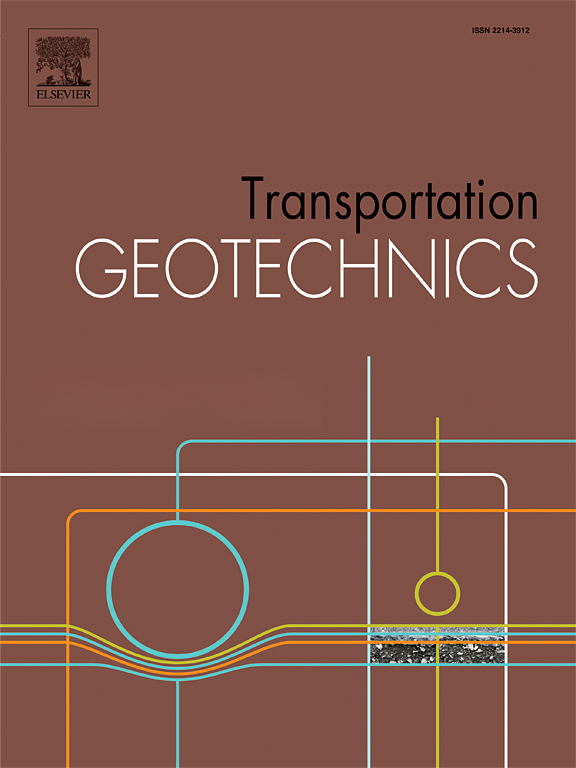Effect of sub-freezing temperatures on ballast strength: A laboratory study
IF 5.5
2区 工程技术
Q1 ENGINEERING, CIVIL
引用次数: 0
Abstract
Ice formation within the ballast layer of railroad track is common in regions that experience consistent temperatures below the freezing point of water. Freely draining ballast cannot retain as much moisture as saturated fouled ballast, which may develop ice-bonded particles depending on the nature of fouling material and moisture present. This paper quantifies and compares the effect of sub-freezing [-17 ± 5°C (0 ± 10°F)] temperatures on ballast strength to non-frozen [21 ± 5°C (70 ± 10°F)] conditions. Ballast specimens were tested in a large-scale direct shear apparatus at gravimetric moisture contents, ranging from 0 % to 12 % of the dry weight of fine material [smaller than 9.5 mm (3/8-in.)], and fouling index (FI) levels ranging from 0 to 40. In non-frozen conditions, addition of moisture and fouling typically reduces the shear strength of ballast, whereas the presence of fouling and absence of moisture typically increases the strength. In a frozen condition, however, the presence of moisture and fouling increased the strength of the ballast due to ice-bonding within the ballast matrix. An increased moisture content yielded higher strengths of moderately and heavily fouled specimens in a nonlinear fashion. Non-fouled samples reduced strength due to less ice-bonding. Interestingly, higher fouling levels nonuniformly changed the strength of the ballast depending upon whether mechanical friction and aggregate interlock or ice-bonding of fine material generated higher strength. Ballast resistance is a key parameter for quantifying the stress state present within the rail, thus requiring accurate assessment of ballast strength in a multitude of environments.
冰点以下温度对压载物强度的影响:实验室研究
在温度持续低于水冰点的地区,铁路压载层内形成冰是很常见的。自由排水的压载物不能像饱和污染的压载物那样保留那么多的水分,根据污染材料的性质和存在的水分,饱和污染的压载物可能会形成冰结颗粒。本文量化并比较了亚冻结[-17±5°C(0±10°F)]温度与非冻结[21±5°C(70±10°F)]条件对压载物强度的影响。压舱物试样在大型直接剪切装置中进行了重量湿含量测试,湿含量范围为细料[小于9.5 mm (3/8-in.)]干重的0%至12%,污垢指数(FI)水平范围为0至40。在非冻结条件下,添加水分和结垢通常会降低压舱物的抗剪强度,而存在污垢和无水分通常会增加压舱物的抗剪强度。然而,在冰冻状态下,由于压舱物基质内的冰结合,水分和污垢的存在增加了压舱物的强度。增加含水率产生较高的强度适度和严重污染的标本在一个非线性的方式。未受污染的样品由于较少的冰结合而降低了强度。有趣的是,较高的污垢水平不均匀地改变了压舱物的强度,这取决于细材料的机械摩擦和骨料联锁或冰结是否产生更高的强度。道砟阻力是量化钢轨内存在的应力状态的关键参数,因此需要在多种环境下准确评估道砟强度。
本文章由计算机程序翻译,如有差异,请以英文原文为准。
求助全文
约1分钟内获得全文
求助全文
来源期刊

Transportation Geotechnics
Social Sciences-Transportation
CiteScore
8.10
自引率
11.30%
发文量
194
审稿时长
51 days
期刊介绍:
Transportation Geotechnics is a journal dedicated to publishing high-quality, theoretical, and applied papers that cover all facets of geotechnics for transportation infrastructure such as roads, highways, railways, underground railways, airfields, and waterways. The journal places a special emphasis on case studies that present original work relevant to the sustainable construction of transportation infrastructure. The scope of topics it addresses includes the geotechnical properties of geomaterials for sustainable and rational design and construction, the behavior of compacted and stabilized geomaterials, the use of geosynthetics and reinforcement in constructed layers and interlayers, ground improvement and slope stability for transportation infrastructures, compaction technology and management, maintenance technology, the impact of climate, embankments for highways and high-speed trains, transition zones, dredging, underwater geotechnics for infrastructure purposes, and the modeling of multi-layered structures and supporting ground under dynamic and repeated loads.
 求助内容:
求助内容: 应助结果提醒方式:
应助结果提醒方式:


